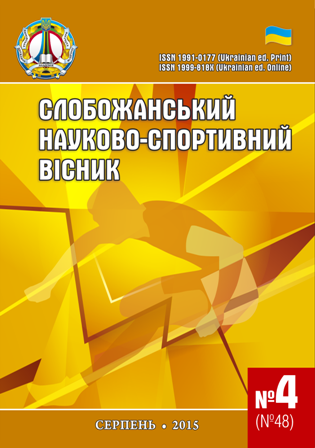Програма навчання базових стрибків у художній гімнастиці на етапі початкової підготовки
DOI:
https://doi.org/10.15391/snsv.2015-4.008Ключові слова:
стрибки, базові, гімнастика, художня, початкова підготовкаАнотація
Мета: удосконалення технічної підготовки спортсменок, які займаються художньою гімнастикою, на етапі початкової підготовки. Матеріал і методи: для розробки програми навчання стрибків спортсменок, які займаються художньою гімнастикою, на етапі початкової підготовки проведено аналіз наукової літератури. Результати: визначено, що засвоєння ритмічної структури елементів значно прискорює та полегшує процес їх вивчення у циклічних (легка атлетика) та ациклічних видах спорту (дзюдо, боротьба). Це є передумовою розробки програми навчання стрибків на основі засвоєння ритму їх виконання. Зазначені різноманітні методи впливу на розвиток відчуття ритму у гімнасток на етапі початкової підготовки та засвоєння ритмічної структури базових стрибків. Висновки: розроблено програму навчання базових стрибків для гімнасток на етапі початкової підготовки, різноманітні методи впливу на розвиток відчуття ритму та засвоєння ритмічної структури елементів. Розроблено проект тренувального заняття для розвитку відчуття ритму та засвоєння ритмічної структури базових стрибківПосилання
Andrееva R. Moloda sportivna nauka Ukraіni [Young sports science Ukraine], 2009, T.1, p. 6–9. (ukr)
Aftimichuk O. Ye. Vіsnik Chernіgіvskogo natsіonalnogo pedagogіchnogo unіversitetu. Vipusk 102. Tom ІІ. Serіya: pedagogіchnі nauki. Fіzichne vikhovannya ta sport [Bulletin Chernihiv National Pedagogical University. Issue 102. Volume II. Series: pedagogical science. Physical education and sport], Chernіgіv, 2012. (rus)
Bakatov V., Antonets V., Chernobay T. Teorіya ta metodika fіzichnogo vikhovannya [Theory and methods of physical education], № 3 (23), 2006, p. 18–24. (ukr)
Bіlokopitova Zh. A., Dyachuk A. M. Fіzichne vikhovannya studentіv [Physical education students], Kharkiv, 2010, №2, p. 24–27. (ukr)
Boloban V. N., Mistulova T. Nauka v olimpiyskom sporte [Science in the Olympic dispute], 1995, № 1 (2), p. 21–29. (rus)
Potop V., Grad R., Boloban V. Pedagogіka, psikhologіya ta mediko-bіologіchnі problemi fіzichnogo vikhovannya і sportu [Pedagogy, psychology and medical-biological problems of physical education and sport], 2013, №9, p. 59–72. (rus)
Viner I. A. Integralnaya podgotovka v khudozhestvennoy gimnastike : avtoref. d. ped. nauk [Integral training in rhythmic gymnastics : doct.of sci. thesis], Sankt-Peterburg, 2013, 55 p. (rus)
Gobuzeva K. V. Modelnyye kharakteristiki gimnastok-khudozhnits s urovnem sportivnoy kvalifikatsii 1-go vzroslogo razryada : avtoref. kand. ped. nauk [Model Specifications gymnasts artists with the level of sports qualification of 1st adult category : PhD thesis], SPb., 2006, 23 p. (rus)
Kazakova M. S., Lagutin A. B. [XXXIX Mezhdunarodnaya nauchno-prakticheskaya konferentsiya], (17–20 aprelya 2001g.) [XXXIX International scientific conference], (17–20 April 2001)], Murmansk, 2001, p. 84–86. (rus)
Karpenko L. A. Uchenyye zapiski universiteta imeni P. F. Lesgafta [Scientific notes University Lesgaft], Vol. 2 (24), 2007, p. 22–26. (rus)
Kaurtseva S. G. Osnovy formirovaniya dvigatelnogo navyka pri vypolnenii slozhnykh gimnasticheskikh uprazhneniy u detey grupp nachalnoy podgotovki: avtoref. kand. ped. nauk. [Basics of motor skill formation when performing complex gymnastic exercises for children of groups of initial training : PhD thesis], Moscow, 1998, 23 p. (rus)
Sukhostav O. A. Individualno-psikhologicheskiye osobennosti v razvitii koordinatsionnykh sposobnostey u devochek 6–9 let, zanimayushchikhsya khudozhestvennoy gimnastikoy, na etape nachalnoy podgotovki : dis. ... kand. ped. nauk [Individually-psychological features in the development of coordination abilities of girls 6-9 years old, engaged in rhythmic gymnastics at the stage of initial training : PhD diss.], Omsk, 1998, 143 p. (rus)
Nesterova T. Nauka v olimpiyskom sporte [Science in the Olympic dispute], 2007, № 1, p. 66–73. (rus)
Platonov V. N., Sakhnovskiy K., Ozimek M. Nauka v olimpiyskom sporte [Science in the Olympic dispute], 2003, № 1, p. 3–13. (rus)
Rotters T. T. Teoreticheskiye aspekty ritmicheskogo razvitiya shkolnika vo vzaimodeystvii fizicheskogo i esteticheskogo vospitaniya: avtoreferat doktora pedagogіchnikh nauk [Theoretical aspects of the rhythm of the student in the interaction of the physical and aesthetic education : doct. of sci. thesis], Kharkіv, 2002, 28 p. (rus)
Suchilin N. Nauka v olimpiyskom sporte [Science in the Olympic dispute], 2012, № 1, p. 84–89. (rus)
Stolov I. I., Ivochkin V. V. Sportivnaya shkola: nachalnyy yetap [Sport school], Moscow, 2007, 140 p. (rus)
Fomina N. A. Formirovaniye dvigatelnykh, intellektualnykh i psikhomotornykh sposobnostey detey 4-6 let sredstvami ritmicheskoy gimnastiki : dis…kand. ped. nauk [Formation of the motor, intellectual and psychomotor abilities of children of 4-6 years means of rhythmic gymnastics : PhD diss.], Volgograd, 1996, 205 p. (rus)
##submission.downloads##
Опубліковано
Як цитувати
Номер
Розділ
Ліцензія
Авторське право (c) 2015 (Oksana Zaplatynska) Заплатинська Оксана Богданівна

Ця робота ліцензується відповідно до Creative Commons Attribution 4.0 International License.
Наше видання використовує положення про авторські права CREATIVE COMMONS для журналів відкритого доступу.
Автори, які публікуються у цьому журналі, погоджуються з наступними умовами:
1. Автори залишають за собою право на авторство своєї роботи та передають журналу право першої публікації цієї роботи на умовах ліцензії Creative Commons Attribution License, котра дозволяє іншим особам вільно розповсюджувати опубліковану роботу з обов'язковим посиланням на авторів оригінальної роботи та першу публікацію роботи у цьому журналі.
2. Автори мають право укладати самостійні додаткові угоди щодо неексклюзивного розповсюдження роботи у тому вигляді, в якому вона була опублікована цим журналом (наприклад, розміщувати роботу в електронному сховищі установи або публікувати у складі монографії), за умови збереження посилання на першу публікацію роботи у цьому журналі.

 До уваги авторів!
До уваги авторів!


